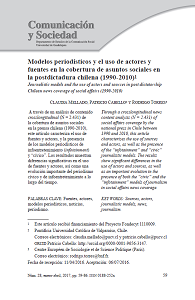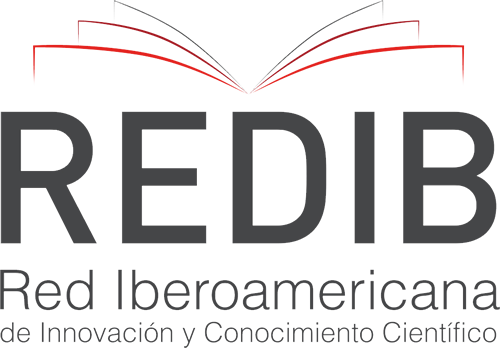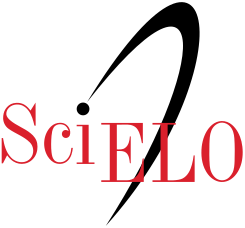Modelos periodísticos, y el uso de actores y fuentes en la cobertura de asuntos sociales en la postdictadura chilena (1990-2010)
DOI:
https://doi.org/10.32870/cys.v0i28.5408Palabras clave:
Fuentes, actores, modelos periodísticos, noticias, periodismoResumen
A través de un análisis de contenido crosslongitudinal (N= 2,431) de la cobertura de asuntos sociales en la prensa chilena (1990 - 2010), este artículo caracteriza el uso de fuentes y actores, y la presencia de los modelos periodísticos de “infotainment” y “cívico”. Los resultados muestran diferencias significativas en el uso de fuentes y actores así como una evolución importante del periodismo cívico y de infotainment a lo largo del tiempo.Descargas
Citas
Arendt, H. (1974). La condición humana. Barcelona: Seix barral.
Berkowitz, D. (2009). Reporters and their sources. En K. Wahl-Jorgensen & T. Hanitzsch (Eds.), The handbook of journalism studies (pp. 102-115). Nueva York: Routledge.
Blumer, H. (1971). Social problems as collective behavior. Social Problems, 18 (3), 298-306.
Blumler, J. & Kavanagh, D. (1999). The third age of political communication: Influences and features. Political Communication, 16 (3), 209-230.
Boyle, M. P., McCluskey, M. R., McLeod, D. M. & Stein, S. E. (2005). Newspapers and protest: An examination of protest coverage from 1960 to 1999. Journalism & Mass Communication Quarterly, 82 (3), 638-653.
Brants, K. & De Haan, Y. (2010). Taking the public seriously: Three models of responsiveness in media and journalism. Media, Culture & Society, 32 (3), 411-428. DOI: 10.1177/0163443709361170.
Cabello, P. & Torres, R. (2015). Conflictos socioambientales y acción colectiva de jóvenes de la región de Los Lagos (Chile). Revista Colombiana de Ciencias Sociales, 6 (2), 253-277.
Carlson, M. (2009). Dueling, dancing or dominating? Journalists and their sources. Sociology Compass, 3 (4), 526-542.
Coleman, S. & Blumler, J. (2009). The Internet and democratic citizenship: Theory, practice and policy. Cambridge: Cambridge University Press.
Contreras-Aguirre, G. & Morales-Quiroga, M. (2014). Jóvenes y participación electoral en Chile 1989-2013. Analizando el efecto del voto voluntario. Revista Latinoamericana de Ciencias Sociales, Niñez y Juventud, 12 (2), 597-615.
CEP (2012). Estudio Nacional de Opinión Pública, julio-agosto 2012. Santiago de Chile: Centro de Estudios Públicos. http://www.cepchile.cl/estudio-nacional-de-opinion-publica-julio-agosto-2012/cep/2016-03-04/095948.html
Dimitrova, D. V. & Strömbäck, J. (2009). Look who is talking: Use of sources in newspapers coverage in Sweden and the United States. Journalism Practice, 3 (1), 75-91.
Donsbach, W. (2008). Journalists’ role perception. En W. Donsbach (Ed.), The International Encyclopedia of Communication (vol. 6, pp. 2605-2610). Malden: Blackwell.
Eide, M. & Knight, G. (1999). Public-private service: Service journalism and the problems of everyday life. European Journal of Communication, 14 (4), 525-547.
Entman, R. (1993). Framing: Toward clarification of a fractured paradigm. Journal of Communication, 43 (4), 51-58.
Entman, R. M. & Rojecki, A. (1993). Freezing out the public: Elite and media framing of the U.S. anti-nuclear movement. Political Communication, 10 (2), 155-173.
Garretón, M. A. (2007). Del postpinochetismo a la Sociedad Democrática. Globalización y política en el bicentenario. Santiago de Chile: Debate.
Garretón, M. A. (2012). Neoliberalismo corregido y progresismo limitado: los gobiernos de la Concertación en Chile, 1990-2010. Santiago de Chile: Universidad de Arte y Ciencias Sociales.
Garretón, M. A., Cruz, M. A. & Aguirre, F. (2012). La experiencia de los consejos asesores presidenciales en Chile y la construcción de los problemas públicos. Revista Mexicana de Sociología, 74 (2), 303-340.
Guerrero, M. A. (2014). The “captured liberal model” of media systems in Latin America. En M. Guerrero & M. Márquez-Ramírez (Eds.), Media systems and communication policies in Latin America (pp. 43-65). Londres: Palgrave Macmillan.
Grabe, M. E., Zhou, S. & Barnett, B. (2001). Explicating sensationalism in television news: Content and the bells and whistles of form. Journal of Broadcasting and Electronic Media, 45 (4), 635–655.
Hanitzsch, T. (2007). Deconstructing journalism culture: Towards a universal theory. Communication Theory, 17 (4), 367-385.
Hopmann, D. N. & Shehata, A. (2011). The contingencies of ordinary citizen appearances in political television news. Journalism Practice, 5 (6), 657-671.
Hughes, S. & Mellado, C. (2016). Protest and accountability without the press. The Press, Politicians, and Civil Society in Chile. International Journal of Press/Politics, 21 (1), 48-67.
Joignant, A. & Menéndez-Carrión, A. (1999). De la “democracia de los acuerdos” a los dilemas de la polis: ¿transición incompleta o ciudadanía pendiente? En A. Menéndez-Carrión & A. Joignant (Eds.), La caja de Pandora. El retorno de la transición chilena (pp. 13-48). Santiago de Chile: Planeta/Ariel.
Jones, B. D. & Baumgartner, F. R. (2005). Politics of attention: How government prioritizes problems. Chicago: University of Chicago Press.
Kleemans, M., Schaap, G. & Hermans, L. (2015). Citizen sources in the news: Above and beyond the vox pop? The International Journal of Press/Politics, 24, 1-18. DOI: 10.1177/1464884915620206
Krippendorf, K. (1997). Metodología de análisis de contenido: teoría y práctica. Barcelona: Paidós.
Lechner, N. (1995). La problemática invocación de la sociedad civil. Espacios (4), 4-13.
Marchetti, D. (2005) Sub-fields of specialized journalism. En R. Benson & E. Neveu (Eds.), Bourdieu and the journalistic field (pp. 64-82), Cambridge: Polity.
Martuccelli, D. (2007). Cambio de rumbo. La sociedad a escala del individuo. Santiago de Chile: LOM.
Marr, M., Wyss, V., Blum, R. & Bonfadelli, H. (2001). Journalisten in der Schweiz: Eigenschaften, Einstellungen, Einflüsse: UVK Medien.
Mayol, A. & Azócar, C. (2011). Politización del malestar, movilización social y transformación ideológica: el caso “Chile 2011”. Polis, 10 (30), 163-184.
McCluskey, M. (2008). Reporter beat and content differences in environmental stories. Journalism & Mass Communication Quarterly, 85 (1), 83-98.
McLeod, D. M. & Hertog, J. K. (1999). Social control, social change and the mass media's role in the regulation of protest groups. En D. Demers & K. Viswanath (Eds.), Mass media, social control and social change: A macrosocial perspective (pp. 305-330). Ames: Iowa State University Press.
Mellado, C. (2015). Professional roles in news content: Six dimensions of journalistic role performance. Journalism Studies, 16 (4), 596-614. DOI:10.1080/1461670X.2014.922276.
Mellado, C. & Lagos, C. (2014). Professional roles in news content: Analyzing journalistic performance in the Chilean national press. International Journal of Communication (8), 2090-2112.
Mellado, C., López, P. & Elórtegui, C. (en prensa). ¿(Para) ciudadanos o espectadores? Periodismo político chileno y sus modelos profesionales de aproximación a la audiencia. Palabra Clave.
Mellado, C. & Van Dalen, A. (2016). Challenging the citizen-consumer journalistic dichotomy: A news content analysis of audience approaches in Chile. Journalism and Mass Communication Quarterly, 1-25. DOI: 10.1177/1077699016629373.
Navia, P. (2004). Participación electoral en Chile, 1988-2001. Revista de Ciencia Política, 24 (1), 81-103.
Nef, J. (1999). Contradicciones en el “modelo chileno”. En A. Menéndez-Carrión & A. Joignant (Eds.), La caja de Pandora. El retorno de la transición chilena (pp. 89-124). Santiago de Chile: Planeta/Ariel.
Neveu, E. (1999) L’approche constructiviste des “problèmes publics”. Un aperçu des travaux anglo-saxons. Études de communication (22), 41-58.
Paredes, J. P. (2011). Ciudadanía, participación y democracia. Deuda y déficit en los 20 años de “democracia” en Chile. Polis, 10 (28), 473-499.
Parker, I. (1992) Discourse dynamics: Critical analysis for social and Individual psychology. Londres: Routledge.
Pritchard, D. & Berkowitz, D. (1993). The limits of agenda-setting: The press and political responses to crime in the United States, 1950-1980. International Journal of Public Opinion Research, 5 (1), 86-91.
Programa de las Naciones Unidas para el Desarrollo-PNUD. (1998). Informe de Desarrollo Humano 1998: Las paradojas de la modernización. Santiago de Chile: Autor.
Reich, Z. (2015). Why citizens still rarely serve as news sources: Validating a tripartite model of circumstantial, logistical, and evaluative barriers. International Journal of Communication, 9, 773-795.
Rochefort, D. A. & Cobb, R. W. (Eds.). (1994). The politics of problem definition: Shaping the policy agenda. Lawrence: University of Kansas Press.
Rosen, J. (1996). Getting the connections right. Public Journalism and the troubles in the press. Nueva York: Twentieth Century Fund Press.
Semetko, H. A. & Valkenburg, P. M. (2000). Framing european politics: A content analysis of press and television news. Journal of Communication, 50 (2), 93.
Shoemaker, P. & Reese, S. (2013). Mediating the message in the 21st Century: A media sociology perspective. Nueva York: Routledge.
Skovsgaard, M. & Van Dalen, A. (2012). The fading public voice. Journalism Studies, 14 (3), 371-386.
Tuchman, G. (1973). Making news by doing work: Routinizing the unexpected. American Journal of Sociology, 79 (1), 110-131.
Uribe, R. & Gunter, B. (2007). Are “sensational” news stories more likely to Trigger viewers' emotions than non-sensational news stories? European Journal of Communication, 22 (2), 207-228.
Vos, T. (2005). Journalistic role conception: A bridge between the reporter and the press. Presentado en International Communication Association (ICA) Conference, Journalism Studies Division, Nueva York, EE.UU.
Walgrave, S. & Van Aelst, P. (2006). The contingency of the mass media's political agenda setting power: Toward a preliminary theory. Journal of Communication, 56 (1), 88-109.

Publicado
Cómo citar
Número
Sección
Licencia
Los autores/as que publiquen en esta revista aceptan las siguientes condiciones:
De acuerdo con la legislación de derechos de autor, los autores conservan los derechos de autoría y otorgan a Comunicación y Sociedad el derecho de primera comunicación pública de la obra. Comunicación y Sociedad no realiza cargos a los autores por enviar y procesar artículos para su publicación.
Los autores/as pueden realizar otros acuerdos contractuales independientes y adicionales para la distribución no exclusiva de la versión del artículo publicado en Comunicación y Sociedad (por ejemplo incluirlo en un repositorio institucional o publicarlo en un libro) siempre que indiquen claramente que el trabajo se publicó por primera vez en Comunicación y Sociedad.










